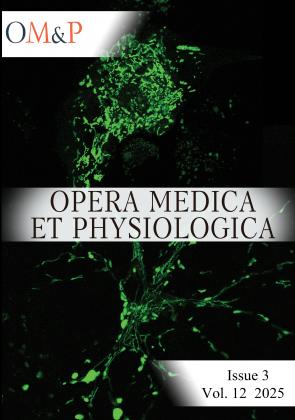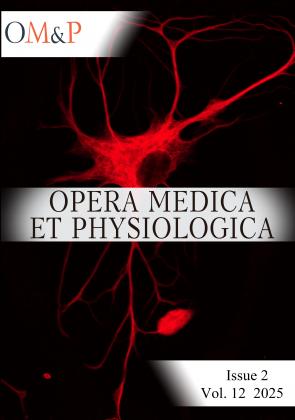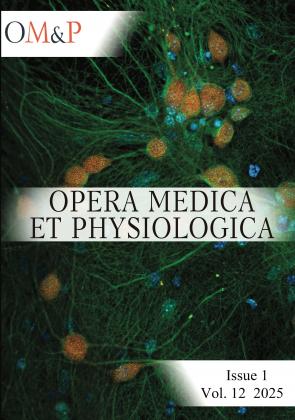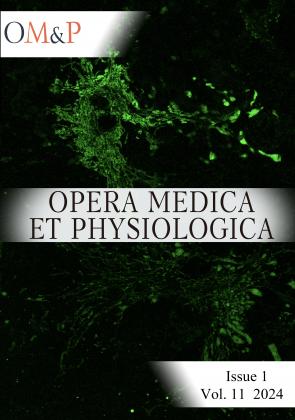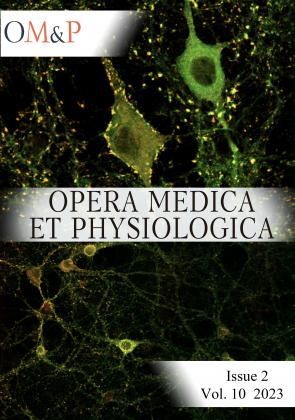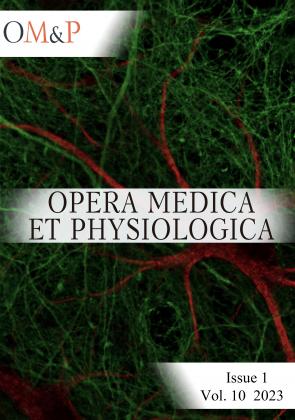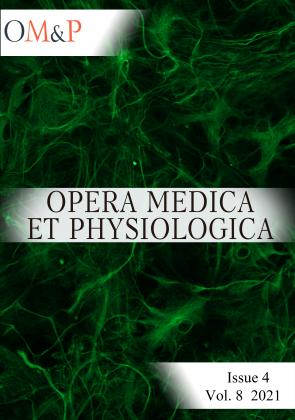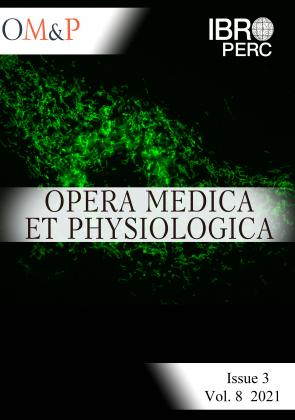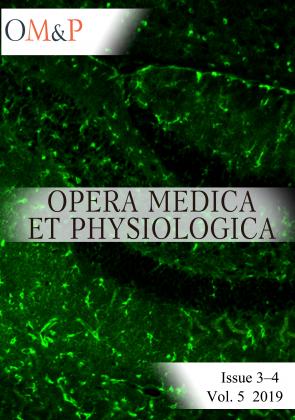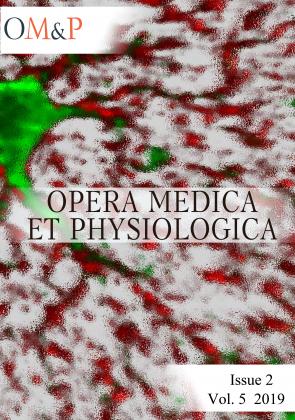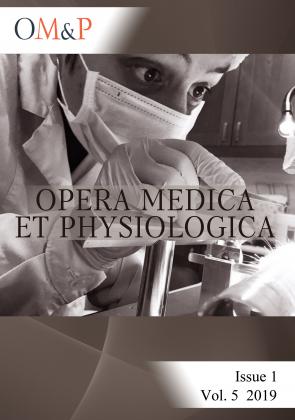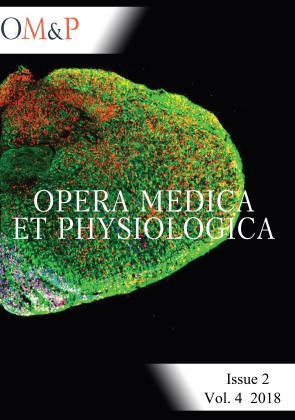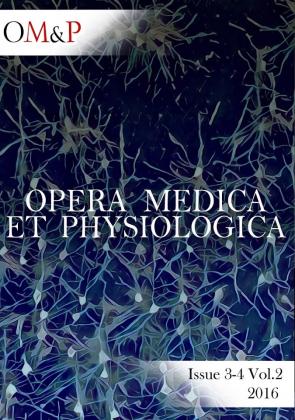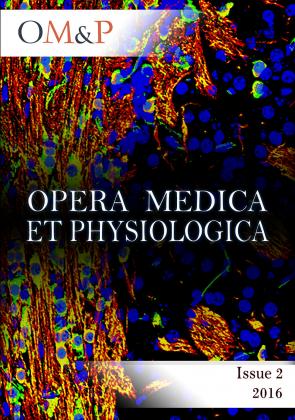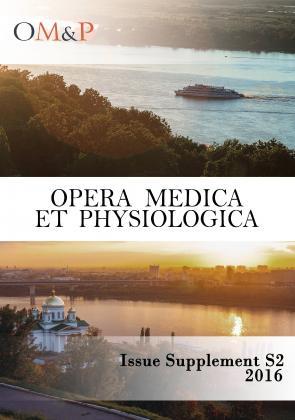Issue 4 | December 2024
Invited review
Published ahead of print December 01, 2024; Printed December 02, 2024; OM&P 2024 Volume 11 Issue 4, pages 60-70; doi:10.24412/2500-2295-2024-4-60-70
Abstract
Full Text
Molecular genetic studies make it possible to determine associations of multifactorial diseases (MFDs) with many specific SNPs, which influence on MFDs etiopathogenesis is often difficult to explain. This is due to the one-sided focus of strategies in the search for mechanisms of these SNPs influence, which are mainly limited to determining the role of protein-coding genes, near or within which these polymorphisms are located. This article provides data on the mechanisms of SNP influence on MFDs etiopathogenesis due to changes in the transposable elements, which leads to their activation, dysfunction or susceptibility to exogenous viral infections. As a result, the relationship of transposable elements with specific proteins, non-coding RNA and epigenetic factors changes, which is a predisposing factor for MFDs development. Indeed, most disease-associated SNPs are located in intronic and regulatory regions of genes, and in intergenic regions. Transposable elements of the human genome are also localized in these places. Therefore, the association of specific SNPs with certain MFDs is due to the different activities of specific transposable elements. Determining the influence of SNPs on transposable elements is promising in bioinformatics studies with the construction of maps of the distribution of these elements in the genome within genes and in intergenic regions with the identification of changes in their structure under the influence of polymorphisms. Using neurodegenerative diseases as an example, it has been shown that pathological functioning and activation of retroelements due to SNPs in the regions of their location in the human genome leads to these MFDs development.
Full-length research paper
Published ahead of print December 01, 2024; Printed December 02, 2024; OM&P 2024 Volume 11 Issue 4, pages 51-59; doi:10.24412/2500-2295-2024-4-51-59
Abstract
Full Text
During cardiac surgery, as well as on-pump CABG, it is crucial to monitor arterial blood parameters in order to assess the condition of patients and risks that might occur in the operating room. In some cases, the cardiac activity of patients undergoing on-pump CABG cannot be self-restored and resuscitation measures are required. Thus, the aim of the study was to analyze the differences between the two groups of patients (self-restoration of cardiac activity vs additional resuscitation measures were required) and identify arterial blood parameters potentially indicating that the patient is at risk. The data of 21 patients were analyzed with Python packages. Statistically significant differences were found between the control group (self-restoration of cardiac activity) and the test group (additional resuscitation measures were required) in the following arterial blood parameters: the levels of sodium, chloride, glucose and blood osmolality. We believe that hyponatremia and blood hypoosmolality might be a reason for cell edema which creates a greater load on the heart and leads to inability of self-restoration of cardiac activity.
Full-length research paper
Published ahead of print December 01, 2024; Printed December 02, 2024; OM&P 2024 Volume 11 Issue 4, pages 40-50; doi:10.24412/2500-2295-2024-4-40-50
Abstract
Full Text
Over the past three decades, the majority of norovirus outbreaks and sporadic cases have been caused by strains of the GII.4 genotype. Notably, this period has seen a periodic change in the norovirus variants within the GII.4 genotype, with some variants acquiring epidemic distribution. Currently, six polymerase gene variants classified as P-type GII.P4 (GII.P4US95, GII.P4FarmingtonHills, GII.P4Hunter, GII.P4Yerseke, GII.P4DenHaag, and GII.P4NewOrleans) are represented in public nucleotide sequence databases, corresponding to GII.4 genotype variants of the gene encoding the main capsid protein VP1 of norovirus. In this study, the nucleotide sequence of the complete RdRp gene was obtained for a strain from Nizhny Novgorod, identified as GII.4Sydney[P4NewOrleans]. According to the results of Bayesian phylogenetic analysis based on RdRp GII.P4 gene sequences available in the GenBank database divided the analyzed strains into clusters according to polymerase variant. Within these clusters, lineages of intervariant recombinants are formed in accordance with the affiliation of the capsid protein variants associated with this polymerase variant. Analysis of the deduced amino acid sequences revealed substitutions specific to different polymerase variants that have emerged and become established within the norovirus population. It appears that the emergence of new norovirus variants within the GII.4 genotype involves selection for strains in which the polymerase and major capsid protein genes have coevolved, conferring certain advantages that facilitate further dissemination. These findings are highly relevant for advancing therapeutic strategies targeting RdRp inhibition for norovirus treatment and for development of specific prophylactic agents.
Full-length research paper
Published ahead of print December 01, 2024; Printed December 02, 2024; OM&P 2024 Volume 11 Issue 4, pages 35-39; doi:10.24412/2500-2295-2024-4-35-39
Abstract
Full Text
The effect of molecular hydrogen (H2) on the functional state of spermatozoa through signaling pathways was studied. In the work, drugs that affect elements of intracellular signaling cascades were used to study the mechanisms of action of H2. We used the adenylatecyclase stimulator – forskolin, the Ca2+-channel blocker – verapamil, and the proteinkinase C inhibitor – staurosporine. We studied concentrations of MDA, ATP, the percentage of total motility and the average speed of spermatozoa under the action of H2 against the background of the action of drugs and without the action of drugs. It was shown that the concentration of MDA in all series did not change. Forskolin causes an increase in sperm motility and velocity. The use of H2 increased the effects stimulated by forskolin: sperm motility and average velocity increased. The concentration of ATP, the percentage of motility and the velocity of sperm decreased under the action of staurosporine and verapamil. The combined action of H2 and verapamil as well as the combined action of H2 and staurosporine determined an increase in sperm motility and velocity. Thus, H2 had a modulating effect through signaling pathways and caused an increase in the functional indices of sperm.
Full-length research paper
Published ahead of print December 01, 2024; Printed December 02, 2024; OM&P 2024 Volume 11 Issue 4, pages 21-34; doi:10.24412/2500-2295-2024-4-21-34
Abstract
Full Text
Chronic kidney disease biomarkers are not studied well yet. Klotho and fibroblast growth factor 23 can be used as sensitive chronic kidney disease biomarkers, as well as single nucleotide polymorphisms of renin-angiotensin-aldosterone system genes may signal the risk of a genetic predisposition to this pathology. In this regard, the purpose of our work is to study the association of polymorphisms of renin-angiotensin-aldosterone system genes with physiological indicators of end-stage renal disease. Levels of fibroblast growth factor 23, Klotho, urea, creatinine, albumin, C-reactive protein, complete blood count parameters were considered in end-stage renal disease patients and control group. Also single nucleotide polymorphisms of AGT (rs4762), AGTR1 (rs5186) and AGTR2 (rs1403543) genes were determined. As a result, a statistically significant increase of fibroblast growth factor 23, urea and creatinine in the plasma of patients with end-stage renal disease was revealed. Statistically significant relationships were found between the complete blood count parameters, between albumin level and parathyroid hormone, between mean corpuscular hemoglobin and C-reactive protein. No difference of the frequency of polymorphisms of the studied genes between the groups was found. An increase of albumin and decrease of Klotho levels were recorded in carriers of the heterozygous genotype of the rs5186 polymorphism and in the case of a complete replacement for the wild allele in the FGFR2 gene (rs1403543) in the group of patients with end-stage renal disease. In the control group a relationship was found between the levels of urea, albumin and creatinine and the carriage of rs4762 and rs1403543 polymorphisms.
Full-length research paper
Published ahead of print December 01, 2024; Printed December 02, 2024; OM&P 2024 Volume 11 Issue 4, pages 13-20; doi:10.24412/2500-2295-2024-4-13-20
Abstract
Full Text
This study investigates the effects of omaveloxolone, a Keap1 inhibitor, on mitochondrial network (MN) dynamics and cell survival under oxidative stress in control fibroblasts and fibroblasts from a Parkinson's disease patient with a PINK1 mutation. The PINK1-mutant fibroblasts showed increased sensitivity to hydrogen peroxide-induced stress. Omaveloxolone pre-treatment improved cell viability under stress conditions in both cell types. Under normal conditions, PINK1-mutant fibroblasts exhibited lower MN connectivity compared to control cells. Oxidative stress reduced MN density in both cell types, while omaveloxolone treatment normalized MN connectivity in PINK1-mutant cells and maintained higher MN connectivity under stress. Similar effects were observed for mitochondrial branch length. Omaveloxolone (50 nM) also increased mitophagy in both cell types under normal conditions. Our findings demonstrate that omaveloxolone exerts protective effects by maintaining mitochondrial dynamics and activating mitophagy. It enhances mitophagy under normal conditions and supports MN structure under oxidative stress, improving cell viability in both control and PINK1-mutant fibroblasts. These results highlight omaveloxolone's potential as a therapeutic agent for protecting cells in diseases associated with impaired mitochondrial dynamics, particularly Parkinson's disease linked to PINK1 mutations.
Full-length research paper
Published ahead of print December 01, 2024; Printed December 02, 2024; OM&P 2024 Volume 11 Issue 4, pages 5-12; doi:10.24412/2500-2295-2024-4-5-12
Abstract
Full Text
This study investigates the effects of the α1-adrenergic receptor agonist methoxamine at various concentrations (10−9 to 10−6 M) on the frequency and characteristics of spontaneous action potentials in right atrial preparations of newborn and adult rats. In newborn rats, methoxamine at all studied concentrations significantly increased the duration of the action potential repolarization phase, while in adult rats, decreasing it. Interestingly, in adult rats, methoxamine at a concentration of (10−6 M), exhibited a dual effect, decreasing the duration of the action potential repolarization phase in some samples while increasing it in others. Stimulation of α1-adrenergic receptors by methoxamine in working cardiomyocytes of the right atrium in both age groups led to an increase in the frequency of action potential generation; however, this effect was more pronounced in newborn rats. These findings highlight the age-dependent effects of α1-adrenergic receptor stimulation on cardiac electrical activity, suggesting that the mechanisms underlying these responses may differ significantly between newborn and adult rats.
Issue 3 | September 2024
Full-length research paper
Published ahead of print September 20, 2024; Printed September 20, 2024; OM&P 2024 Volume 11 Issue 3, pages 174-188; doi:10.24412/2500-2295-2024-3-174-188
Abstract
Full Text
Introduction. Acute limb ischemia is a critical condition requiring immediate revascularization. The risk of complications is affected by age, coronary heart disease, chronic kidney disease, respiratory failure, diabetes mellitus, thrombosis etiology, urgency and duration of surgery. The aim of the study was to evaluate the influence of the presented risk factors on the results of open revascularization for acute thrombosis in patients with acute COVID-19. Materials and methods. The results of open surgical treatment of acute limb ischemia of Rutherford class II in patients with acute COVID-19 (86 patients, group I) and 50 patients without COVID-19 (group II) were analyzed. Results. In-hospital mortality was 73.2% in group I and 12% in group II. Most deaths in group I were due to early rethrombosis. Risk factors - coronary heart disease, chronic kidney disease, diabetes mellitus, age >75 years had a greater negative impact in group I against the background of coronavirus infection. Conclusion. In patients in the acute stage of COVID-19, open revascularization is associated with a higher risk of complications and mortality in the early postoperative period relative to patients who underwent surgery without coronavirus infection. The impact of all the identified risk factors increases against the background of COVID-19, a statistically significant increase in the odds ratio of developing postoperative complications was found for such perioperative risk factors as: coronary heart disease, respiratory failure, polyvalent etiology of thrombosis and age over 75 years, among the intraoperative factors, the emergency nature of the operation and the duration of the surgical intervention are significant.
Full-length research paper
Published ahead of print September 20, 2024; Printed September 20, 2024; OM&P 2024 Volume 11 Issue 3, pages 158-173; doi:10.24412/2500-2295-2024-3-158-173
Abstract
Full Text
The transition of the ion channel between the open and closed states is traditionally considered random. Current experimental data indicated the presence of oscillatory modes of regulation of open/closed states, and possible connections between these modes. The canonical methods Fourier or wavelet transforms, fractal analysis and mathematical modelling can evaluate open/closed states oscillatory modes, but cannot describe their relationship to each other. We first applied the method of bispectral analysis to solve this problem. The well-described potassium channels potential-dependent Kv, calcium-dependent KCa and the modelled potassium channel KcsA were studied. The relationship between fluctuations open/closed lifetimes at frequencies ~0.1, ~1 and ~10 Hz was shown. These frequencies correspond to rhythmic processes in cardiovascular and nervous systems functioning, including those regulated by potassium channels. The normalised integrated bispectrum index was chosen to quantitatively evaluate the interrelation of ion channel opening/closing states. The normalised bispectrum index notable increased upon alteration of the membrane potential from 0 to 20 mV. The obtained data expand our understanding of ion channel functioning principles and can be used in the search for new approaches to the pathological states (channelopathies) therapy.
Full-length research paper
Published ahead of print September 20, 2024; Printed September 20, 2024; OM&P 2024 Volume 11 Issue 3, pages 152-157; doi:10.24412/2500-2295-2024-3-152-157
Abstract
Full Text
Сholelithiasis is a multifactorial process that is influenced by both environmental and genetic factors. Some evidence suggests that total plasma homocysteine correlates with the presence of gallstones, suggesting that hyperhomocysteinemia is a risk factor for cholelithiasis. The aim of this work was to analyze the association of polymorphic variants of the methylenetetrahydrofolate reductase MTHFR (rs1801133 (677C > T), rs1801131 (1298A > C)) and methionine synthase reductase MTRR (rs1801394 (66A > G)) genes with the development of gallstone disease in individuals from the Republic of Bashkortostan. DNA samples from 196 patients with cholelithiasis and 274 healthy individuals aged 23-87 years living in the Republic of Bashkortostan were used as research material. Genotyping was performed using the real-time PCR method. It has been established that the rs1801133*T allele and the rs1801133*TT genotype of the MTHFR gene are markers of an increased risk of developing cholelithiasis. An association was established between the rs1801133*TT genotype of the rs1801133 polymorphic variant of the MTHFR gene and the moderate severity of cholelithiasis and hereditary burden in patients with cholelithiasis. A study of the polymorphic variant of the MTRR gene revealed that the rs1801394*G allele increases the risk of cholelithiasis. Analysis of associations of the polymorphism rs1801131 of the MTHFR gene with the development of cholelithiasis did not reveal statistically significant differences between the compared groups of patients and controls. Determination of homocysteine levels and genetic testing of MTHFR and MTRR polymorphisms in patients with cholelithiasis may be useful in clinical practice.
Full-length research paper
Published ahead of print September 20, 2024; Printed September 20, 2024; OM&P 2024 Volume 11 Issue 3, pages 136-151; doi:10.24412/2500-2295-2024-3-136-151
Abstract
Full Text
This work is devoted to the study of mRNA expression patterns and the relative content of selenoproteins in mice with TAA-induced liver fibrosis and TAA-induced HCC. The main objective of this study is to evaluate the activation or suppression of selenoprotein synthesis during HCC progression and directly in the tumor in one TAA-treated mouse model, which is a pilot study and allows us to closely approximate the situation observed during HCC progression in vivo. It was found that as HCC progresses, there is an increase in the mRNA expression of thioredoxin reductases TXNRD1 and TXNRD2, deiodinase DIO3, glutathione peroxidases GPX1, GPX2, GPX4, and an inverse correlation in the expression of mRNA was characteristic of GPX3. In addition, the mRNA expression of endoplasmic reticulum resident selenoproteins: SELENOM, SELENON, SELENOT and SELENOS changed significantly. Also, in tumor liver samples and directly in the tumor itself, an increase in the expression of the selenoprotein SELENOP was recorded. The information obtained from the results of this work will significantly complement the existing data on the role of mammalian selenoproteins in various liver pathologies and in oncogenesis in general.
Full-length research paper
Published ahead of print September 20, 2024; Printed September 20, 2024; OM&P 2024 Volume 11 Issue 3, pages 118-135; doi:10.24412/2500-2295-2024-3-118-135
Abstract
Full Text
The study of the severity and consequences of infectious diseases is a relevant subject of research throughout the world, which was directly demonstrated by the situation with the 2020-2023 coronavirus pandemic. In our study, we analyzed a distribution of genotypes and alleles frequency of polymorphic variants of the IL6 rs1800795, TNFA rs1800629 and LZTFL1 rs10490770 gene polymorphisms, which were previously linked to the pathogenesis of COVID-19, in populations of Burzyan Bashkirs, Sterlibashevsky Bashkirs, Permsky Bashkirs, Kazan Tatars, Chuvash, Udmurts, Mari, Komi and Mordvins. Statistically significant differences were identified in the IL6 rs1800795 between the populations of the Burzyan Bashkirs and the Mari and Komi (p < 0.05). The Sterlibashevsky Bashkirs, Permsky Bashkirs and Udmurts also statistically significantly differed from the Komi population (p < 0.05). When studying the TNFA rs1800629, statistically significant differences were identified between the populations of Sterlibashevsky and Permsky Bashkirs and the Udmurts population (p < 0.05). Analysis of the LZTFL1 rs10490770 revealed statistically significant differences only between the Udmurt and Mari populations (p < 0.05). The data indicate that despite the geographic proximity of the examined populations of the Volga-Ural region, they were able to preserve the uniqueness of their gene pool.
Full-length research paper
Published ahead of print September 20, 2024; Printed September 20, 2024; OM&P 2024 Volume 11 Issue 3, pages 108-117; doi:10.24412/2500-2295-2024-3-108-117
Abstract
Full Text
The aim: determination of correlation dependence of adaptogenic defense reactions in rats in the acute phase of pain stress on laser-puncture exposure to low-intensity IR radiation. Material and methods. Four groups of rats were used in the work: "experimental", which received after the injury a 10-day course of PPBM, and three comparison groups ("intact", "no exposure" and "placebo"). The intensity of lipid peroxidation, specific activity of antioxidant enzymes, protein concentration, malonic dialdehyde content in blood plasma and erythrocytes were determined by spectrophotometric method. Microcirculation indices were evaluated according to the previous series of our studies. Emotional and behavioral reactions were studied in the "open field" test. Results. Normalization of metabolic, microcirculatory and behavioral indices was registered in the experimental group. The correlation coefficients between the microcirculation index and the data of behavioral activity under pain stress were significantly less than the correlation coefficients between oxidative stress and cognitive functions, which confirms the determining role of oxidative metabolism disturbance in the formation of cognitive disorders. Conclusion: the registered adaptation and stress-limiting effect of PPBM in conditions of experimental pain stress allows us to recommend the technology of laser acupuncture for use in complex rehabilitation of patients with pain syndrome.
Full-length research paper
Published ahead of print September 20, 2024; Printed September 20, 2024; OM&P 2024 Volume 11 Issue 3, pages 93-107; doi:10.24412/2500-2295-2024-3-93-107
Abstract
Full Text
A hypothesis is proposed about the role of evolutionary relationship of retroelements with transfer RNAs (tRNAs) on their processing to form small non-coding RNAs. This is evidenced by the use of tRNA as primers for reverse transcriptase, origin of SINE2 from tRNA, use of LINE1 enzymes by tRNA for pseudogenes formation. Under the influence of RISC enzymes, tRFs are formed from tRNA, that control gene expression at the epigenetic level. Non-coding RNAs formed from transcripts of retroelements are characterized by similar properties. An assumption has been made about the functioning of a species-specific epigenetic network between such non-coding RNAs formed from retroelements and tRNAs. Decoding such a network may open up the possibility of creating new epigenetic agents for the treatment of human diseases, and will also allow us to determine mechanisms of genetic code emergence in evolution. One of the bases for this network formation may be the distribution and composition of tRNAs and retroelements in the genome. I have provided data on this network mechanisms formation, describing the similar functional properties of tRNAs and retroelements, their influence on the same targets and pathways in the human organism. I suppose that the relationship between tRNAs and retroelements arose as an integral property of living things when life arose in RNA world, where tRNAs were originally used to perform many regulatory catalytic functions, one of which was later transformed into the transfer of amino acids for protein synthesis.
Invited review
Published ahead of print September 20, 2024; Printed September 20, 2024; OM&P 2024 Volume 11 Issue 3, pages 67-92; doi:10.24412/2500-2295-2024-3-67-92
Abstract
Full Text
The paper presents an analysis of literature data on the characteristics of microbiocenoses across a wide range of infectious and somatic pathologies, as well as the results of our research on changes in the composition of the gastrointestinal tract microbiota in patients with various diseases. It is demonstrated that the microbiota responds consistently to any pathological changes occurring in the host organism, primarily manifested as a disruption in the balance between anaerobic (bifidobacteria, lactobacilli, bacteroids, clostridia, etc.) and aerobic components of the microbiocenosis. The predominance or suppression of specific types of microorganisms is primarily influenced by the composition of the individual's indigenous microbiota, rather than the specific pathology associated with dysbiosis.
Full-length research paper
Published ahead of print September 20, 2024; Printed September 20, 2024; OM&P 2024 Volume 11 Issue 3, pages 58-66; doi:10.24412/2500-2295-2024-3-58-66
Abstract
Full Text
Background: previous studies have implicated the INSIG2 rs6726538 single nucleotide polymorphism (SNP) as a potential risk factor for cervical cancer. Our objective was to examine the correlation between this genetic variation and the vulnerability of Iraqi women to cervical cancer. Methods: this case-control study analyzed rs6726538 genotypes and allele frequencies in 109 cervical cancer cases and 109 healthy controls. Logistic regression calculated odds ratios (OR) and 95% confidence intervals (CI). The rs6726538 SNP was genotyped using tetra-primer ARMS-PCR. Results: the AT genotype occurred more frequently in cases than controls (52.2% vs 34%, OR 0.783, 95% CI 0.38-1.25, p = 0.0391). The TT genotype was less common but showed a non-significant decreased cancer risk versus AA (OR 0.336, 95% CI 0.17-0.96, p = 0.0707). The T allele was significantly higher in cases (36.3% vs 20.6% in controls, p = 0.0023), while the A allele was higher in controls (79.4% vs 63.7% in cases, p = 0.05). Conclusion: this preliminary data indicates that the rs6726538 T allele and TT genotype may be associated with increased cervical cancer risk, while the A allele and AA genotype could have a protective effect. However, larger studies are required to validate these initial findings on how this SNP may impact cervical cancer susceptibility.
Full-length research paper
Published ahead of print September 20, 2024; Printed September 20, 2024; OM&P 2024 Volume 11 Issue 3, pages 49-57; doi:10.24412/2500-2295-2024-3-49-57
Abstract
Full Text
In the present study, we investigated the effect of α1-adrenergic receptor stimulation on the electrical activity of the right atrium cardiomyocytes with imposed rhythm in rats of different ages using methoxamine and methoxamine against the background of selective blockade of phospholipase C inhibitor (U-73122). Methoxamine increased the duration of the repolarization phase of the action potential. However, there were no changes in the other electrophysiological parameters studied. U-73122 markedly blocked all effects of α1-adrenoreceptor stimulation on the parameters of the electrical activity of working cardiomyocytes in 7-, 21-, and 100-day-old rats.
Full-length research paper
Published ahead of print September 20, 2024; Printed September 20, 2024; OM&P 2024 Volume 11 Issue 3, pages 41-48; doi:10.24412/2500-2295-2024-3-41-48
Abstract
Full Text
Discovering alternate methods to treat cancer has been the focus of several investigations. The preventive benefits of β-glucan against liver damage, toxicity, and alteration in antinuclear antibody (ANA), alpha-fetoprotein (AFP), and anti-double strand DNA antibody (anti-dsDNA) caused by Ehrlich ascites carcinoma (EAC) are investigated in this study. A total of 40 mice weighing between 20-25 g, were divided randomly into four groups: the control group, the β-glucan group (200 mg/kg bw/day for two weeks), the EAC group, and the EAC+β-glucan group. The most recent research demonstrated that EAC damaged the liver and increased serum levels of AFP, anti-dsDNA, alanine transaminase (ALT), aspartate transaminase (AST), and alkaline phosphatase (ALP). However, compared to the control, serum total proteins and albumin levels considerably decreased. EAC therapy with β-glucan enhanced liver structure and function. As a result, it is possible that suggests that β-glucan can help prevent and treat liver toxicity.
Full-length research paper
Published ahead of print September 20, 2024; Printed September 20, 2024; OM&P 2024 Volume 11 Issue 3, pages 32-40; doi:10.24412/2500-2295-2024-3-32-40
Abstract
Full Text
Mycobacterium tuberculosis, a species of pathogenic bacteria in the Mycobacteriaceae family, is the infectious agent that causes tuberculosis (TB), one of the most progressive bacterial pathogens in human history. The pathogen is the first cause of mortality linked to a single pathogen worldwide, especially in poor and developing countries. There are two clinical manifestations of disease caused by this bacterium: pulmonary tuberculosis (PTB) and extrapulmonary tuberculosis (EPTB). A single nucleotide polymorphism (SNP) in the human caspase recruitment domain-containing protein 8 (CARD8) gene of TB infection plays a critical role in the disease progression. Combining this SNP with the CARD8 polymorphism increased the effect, indicating a new link between the CARD8 gene and TB infection. The present study was conducted to determine the association between the polymorphism of the CARD8 gene and EPTB infection in humans. The study included patients (males and females) infected with PTB (n = 50), and EPTB (n = 50), as well as 50 healthy individuals as a control group. Blood samples were collected from all the participants and used to isolate DNA. Using a self-designed nested tetra-primer amplification refractory mutation system-polymerase chain reaction (T-ARMS PCR) assay, the genotypes in CARD8 A/T SNPs were identified. The results showed that there were no significant differences between the types of patients themselves and no significant differences between patients and healthy individuals in the results of ARMS-PCR. The findings of the present study revealed a correlation between patients with EPTB and polymorphisms in CARD8 (rs2043211).
Invited review
Published ahead of print September 20, 2024; Printed September 20, 2024; OM&P 2024 Volume 11 Issue 3, pages 24-31; doi:10.24412/2500-2295-2024-3-24-31
Abstract
Full Text
The potential role of proteolytic enzymes in impeding the growth of cancer by the anti-angiogenesis process has gained attention recently. This review explores proteolytic enzymes that have been studied for their capacity to obstruct the development of new blood vessels that are essential for the growth of tumors. These enzymes include matrix metalloproteinase and serine proteases. The mechanisms by which these enzymes inhibit angiogenesis including degradation of extracellular matrix proteins and inhibition of signaling pathways involved in blood vessel formation are discussed. Also, proteolytic enzymes’ possible therapeutic applications as anti-angiogenesis drugs in the treatment of cancer are highlighted.
Full-length research paper
Published ahead of print September 20, 2024; Printed September 20, 2024; OM&P 2024 Volume 11 Issue 3, pages 14-23; doi:10.24412/2500-2295-2024-3-14-23
Abstract
Full Text
Background: the nucleus pulposus NP pulls on the ruptured annulus fibrosus AF, bulging the intervertebral disc IVD and releasing chemicals that may irritate nerves and cause inflammation and pain. This produces histological changes to the IVD, including less gelatinous NP, cracks and fissures, decreased matrix water content, and proteoglycan composition changes. Aim of study: this study aims to investigate the histopathological changes in the Herniated Disc HD tissue, as well as cartilage histopathology grade and stage assessment. Materials and methods: fourty tissue samples of lumbar HD obtained after the operations were kept in 10% formalin. Then all HD sections were processed, and embedded, after that, 5 μm thick glass mounted sections were stained with Hematoxylin and Eosin and Alcian blue (pH 0.02) and examined microscopically for histopathological changes and grading scoring was also conducted based on cell density, structural alterations of collagen fibers, and proteoglycan degeneration. Results: hemorrhage with fibrin deposition, mucous degeneration around chondrocyte clones and degeneration, increased chondrocyte density, expanded lacunae with degenerated chondrocytes, fiber disorientation, cleft formation, mucoid matrix changes, and inflammatory cell infiltration with fibrocyte prefiltration were the most histopathological changes in HD samples. Along with necrotic chondrocyte increase and tissue fiber alterations. Histological cell density grade indicated different-sized clones. All HD tissues revealed collagen fiber structural alterations, with gradients (52.5%) being most common. All HD samples showed mucous (proteoglycans) degradation, especially in gradients abundantly present and intermediate between 1 and 3 (45% and 42.5%). Conclusions: histopathological changes in intervertebral disc associated with HD infection.
Full-length research paper
Published ahead of print September 20, 2024; Printed September 20, 2024; OM&P 2024 Volume 11 Issue 3, pages 5-13; doi:10.24412/2500-2295-2024-3-5-13
Abstract
Full Text
A varicocele is the most common rectification cause of male infertility. It is an abnormal dilation of the veins of the pampiniform plexus in the spermatic cord. It is estimated to affect 10-15% of men and adolescents. The aim of the current study was to investigate the immunological parameters, gene expression profiles, and their correlations in varicocele and non-varicocele oligospermic patients compared to healthy controls, providing insights into the molecular mechanisms underlying male infertility. A total of 120 males were involved in this study over the period from October 2023 to January 2024. Blood and semen samples were collected from patients who were diagnosed with varicocele confirmed oligospermia (40 samples) and non-varicocele oligospermic patients (40 samples), in addition to 40 apparently healthy males as control. The level of IL-18 and IL-37 was estimated in the serum of tested groups using Enzyme Linked Immunosorbent Assay (ELISA) technique. The serum levels of the pro-inflammatory cytokine IL-18 were significantly elevated in all patient groups compared with control. Interestingly, the anti-inflammatory cytokine IL-37 was also significantly increased. The gene expression of heat shock protein A2 (HSPA2) was detected using reverse transcriptase polymerase chain reaction (RT-PCR). The fold of gene expression results by RT-PCR technique revealed a significant downregulation of HSPA2 (0.3453 ± 0.311-fold) gene expression in varicocele patients and a 0.154 ± 0.13-fold decrease in non-varicocele oligospermia compared with control. However, no significant correlation was found between the expression of HSPA2 and the levels of IL-18 and IL-37.
Issue 2 | June 2024
Full-length research paper
Published ahead of print June 25, 2024; Printed June 26, 2024; OM&P 2024 Volume 11 Issue 2, pages 159-167; doi:10.24412/2500-2295-2024-2-159-167
Abstract
Full Text
MicroRNAs play a crucial role in the regulation of biological processes variety associated with neoplasm development and progression, such as cell proliferation and differentiation, apoptosis, angiogenesis, inflammation, migration, invasion and metastasis, epithelial-mesenchymal transition and others. The purpose of this work was to investigate the DNA methylation level of miR-152 in 25 paired tissue samples from patients with an established diagnosis of ovarian cancer and various histological and clinical characteristics by the MS-HRM method. Our results indicate a higher frequency of the miR-152 methylation in ovarian tumor tissues (51.5% ± 5.4) compared to normal tissues (43.9% ± 7.2), however, the differences did not reach the statistical level significance, p = 0.5. There was no relationship between the metastatic process in the tumor depending on the level of methylation (46.5% ± 11.9 in patients with metastases vs 45.2% ± 7.8 in cases without metastases). One patient with the highest methylation level of all samples researched – 89.91%, despite a good response to primary therapy, had a relapse of the disease after 7 years. In addition, there is a tendency for a lower level of miR-152 methylation in patients with a complete response to therapy, in contrast to women with a partial response or the tumor process stabilization. Thus, our research provides evidence in favor of the suppressor function of the miR-152 in tumor, and its possible role in sensitivity to polychemotherapy, however, the results did not reach a statistical level of significance and additional studies on larger material are required.
Full-length research paper
Published ahead of print June 25, 2024; Printed June 26, 2024; OM&P 2024 Volume 11 Issue 2, pages 148-158; doi:10.24412/2500-2295-2024-2-148-158
Abstract
Full Text
Haemophilus influenzae is one of the most common causative agents of community-acquired pneumonia (CAP). Gene recombinations and high polymorphism make it difficult to diagnose the pathogen even by methods of molecular genetics. The development of DNA microarrays for H. influenzae detection in clinical samples of patients with CAP is promising. The aim of this work was to evaluate the possibility of detection of H. influenzae in clinical samples of patients with CAP using DNA microarray. Oligonucleotide probes were selected using disprose program and sequences from NCBI Nucleotide. Probes capable of cross-linking with H. haemolyticus and H. parainfluenzae DNA were removed in order to exclude nonspecific interaction. Probes were tested as part of DNA microarray design using samples of nucleic acid from tracheal aspirates of children with CAP. H. influenzae detection frequency in clinical samples was determined using sputum samples, tracheal aspirates and pharyngeal swabs of children and adults with CAP. The prevalence of the hybridization signal of the specific probes over 3 standard deviations of the hybridization signal of the negative control probes was interpreted as positive. The results were validated by PCR. 22 probes for H. influenzae detection with DNA microarray were selected. The hybridization signal of probes exceeded the threshold while testing samples containing H. influenzae DNA and did not exceed the threshold value while testing negative samples. H. influenzae detection frequency among patients with CAP was assessed. The results can be used for development of diagnostic tools for establishing the etiological factor of CAP.
Full-length research paper
Published ahead of print June 25, 2024; Printed June 26, 2024; OM&P 2024 Volume 11 Issue 2, pages 139-147; doi:10.24412/2500-2295-2024-2-139-147
Abstract
Full Text
The aim of this study was to evaluate the effects of two variants of the Daedaleopsis confragosa fungus extract, F-1368 strain, differing in polysaccharide concentration, on five human cancer cell lines (U-87 MG, C-33 A, SK-Mel-28, MDA-MB-231, SW620) in vitro. Standard cytotoxicity assessment methods, including MTT-assay and clonogenic assay, were employed. Additionally, an experiment was conducted on laboratory SCID mice with heterotopic xenografts of human glioblastoma U-87 MG, where the test preparations were administered subcutaneously into the tumor area. Tumor sizes were measured using a caliper, and upon euthanasia, xenografts were histologically examined with hematoxylin-eosin staining under a light microscope. Results from MTT and clonogenic assays demonstrated that F-1368 extracts reduced the viability, mitochondrial function, and proliferative activity of tumor cells in vitro. However, a threefold increase in polysaccharide concentration in one of the extracts did not significantly enhance its cytotoxicity against tumor cells in vitro. Furthermore, one extract was tested on U-87 MG cell xenografts, revealing a reduction in tumor growth in SCID mice. The maximum tumor growth inhibition index for U-87 MG cells reached 50.7% at 21 days post-commencement of extract injections. These findings suggest that the D. confragosa F-1368 strain holds promise for investigating both in vitro and in vivo models of antitumor activity and identifying potential bioactive molecules or compounds.
Full-length research paper
Published ahead of print June 25, 2024; Printed June 26, 2024; OM&P 2024 Volume 11 Issue 2, pages 129-138; doi:10.24412/2500-2295-2024-2-129-138
Abstract
Full Text
The aim was to study macrolide resistance of erm B -positive H.pylori in patients with newly diagnosed and recurrent helicobacteriosis in Nizhny Novgorod. Materials and methods: PCR detection of H.pylori DNA in gastric juice and biotopes of the mucous membrane of the gastric antrum was performed in 3450 patients with gastroenterological diseases. To identify the ermB gene associated with macrolide resistance, domestic commercial PCR test systems were used. Results: from 2005 to 2023 there was a progressive reduction in visits for gastric and duodenal ulcers. The dynamics of primary and secondary genetic H.pylori macrolide resistance increased continuously from 2011 to 2014 and stabilized thereafter. From 2014 to 2023, the proportion of patients with ermB gene positive H.pylori infection increased approximately 2-fold (to 17.0% in 2018). In patients with a history of eradication therapy, the minimum detection rate of the ermB gene was established in 2011. Since 2012, there has been an increasing detection rate of secondary H.pylori macrolide resistance to 35.4% in 2022. Conclusions: during the observation period, a progressive reduction in the proportion of patients with gastric and duodenal ulcers among patients with gastroenterological diseases was revealed. The study of primary and secondary H.pylori macrolide resistance showed an increase in the detection rate of resistant isolates in Nizhny Novgorod. The study of genetic H.pylori macrolide resistance is necessary when re-identifying in patients with a history of eradication therapy and in patients who took clarithromycin for other reasons for the optimal selection of drugs included in the re-treatment regimen of infection.
Full-length research paper
Published ahead of print June 25, 2024; Printed June 26, 2024; OM&P 2024 Volume 11 Issue 2, pages 120-128; doi:10.24412/2500-2295-2024-2-120-128
Abstract
Full Text
Gastric cancer (GC) is one of the most common cancer types in the world with a high mortality rate. It is assumed that polymorphisms of the NFKB1 gene that disrupt its expression predispose to the development of epithelial cancer, including GC. The aim of this study is to explore the association of polymorphism rs28362491 of NFKB1 gene with the risk of GC development for individuals from the Volga-Ural region of Russia. The samples for the study were the DNA of 374 patients with GC and 365 healthy donors of various ethnicities (Russians, Tatars, Bashkirs). It was shown that in all studied groups the most common heterozygous genotype ID of the polymorphic locus rs28362491 of the NFKB1 gene, alleles I and D occur with similar frequencies. Also, it has been established that for Tatars, allele D of the rs28362491 polymorphic locus of the NFKB1 gene is a marker of an increased risk of developing GC, and allele I and genotype II are markers of a reduced risk of developing GC. Meta-analysis showed statistically significant differences in the distribution of allele frequencies of the polymorphic locus rs28362491 of the NFKB1 gene between patients with cancer and controls when combining samples of Tatars and Bashkirs. We hypothesize that polymorphism rs28362491 of the NFKB1 gene may contribute to the genetic structure of susceptibility to GC.
Invited review
Published ahead of print June 25, 2024; Printed June 26, 2024; OM&P 2024 Volume 11 Issue 2, pages 108-119; doi:10.24412/2500-2295-2024-2-108-119
Abstract
Full Text
Epigenetic regulation of spatiotemporal gene expression in ontogenesis is determined by programmed species-specific activations of retroelements in successive cell divisions. Evolutionary selection of this genome control mechanism is aimed at achieving a mature state, after which unprogrammed activation of retroelements occurs, which expression products stimulate interferon response, aseptic inflammation and aging-associated diseases development, such as atherosclerosis. Interferon in atherosclerosis stimulates pro-inflammatory macrophage phenotype, which contributes to pathological immune response, foam cell formation and atherosclerosis progression. Activation of retroelements occurs under the influence of viral infections, which role in atherosclerosis development has been proven, which confirms my hypothesis. Dysfunctional foam macrophages produce HERV-K102, which stimulates innate immunity, HERV-K HML2 expression correlates with macrophage immune activation and interferon response. Data were obtained on association with atherosclerosis of microRNAs derived from retroelements, which are involved in the disease pathogenesis due to their influence on cholesterol metabolism (miR-498, -520d), immune processes (miR-1257, -28, -2909), activation of DNMT1 (miR-1264) and EZH2 (miR-630), gene expression in endothelial cells (10 specific miRNAs), vascular smooth muscle cells (14 specific miRNAs) and macrophages (miR-320b, -326, -378, -384), contributing to pathological phenotype of these cells. In atherosclerosis microRNAs derived from retroelements interact with circular RNAs (miR-495, -576, -579, -630, -633, -637, -942) and long non-coding RNAs (miR-326, -4731, -495, - 616, -641, -664a) the key sources of which are retroelements. Role of ANRIL, NEAT1, PAPIA, MAARS, VINAS, H19, AK136714, MIAT, and interaction of Alu elements with ANRIL and NEAT1, identified in atherosclerosis development. The data obtained can become the basis for targeted effect on retroelements activation in atherosclerosis using microRNAs.
Invited review
Published ahead of print June 25, 2024; Printed June 26, 2024; OM&P 2024 Volume 11 Issue 2, pages 90-107; doi:10.24412/2500-2295-2024-2-90-107
Abstract
Full Text
The focus of this review is on the study of aberrant metabolism in brain cells in Parkinson's disease. Parkinson's disease is the second most prevalent neurodegenerative disorder, characterized by the aggregation of the pathological protein α-synuclein, loss of dopaminergic neurons in the compact part of the substantia nigra, leading to a combination of motor and non-motor symptoms. While the hallmark motor symptoms of PD are well-documented, emerging research sheds light on intricate metabolic changes occurring at the cellular level, providing new insights into the pathophysiology of the disease. Studying the role of endogenous small molecules in protein-metabolite intermolecular interactions, conformational rearrangements of protein molecules, especially membrane receptors and transporters in regulating blood-brain barrier permeability, modulation of signaling transduction processes in neuroinflammation and neurodegeneration, remains pertinent.
Full-length research paper
Published ahead of print June 25, 2024; Printed June 26, 2024; OM&P 2024 Volume 11 Issue 2, pages 74-89; doi:10.24412/2500-2295-2024-2-74-89
Abstract
Full Text
Injury to the proximal part of the equine suspensory ligament (SL), called proximal suspensory desmitis (PSD), commonly causes lameness in horses. PSD is extremely difficult to manage and treat, with present methods often unable to achieve full recovery, especially in chronic cases. The present study was the first to use gene therapy to restore moderate and severe injuries of the proximal suspensory ligament in horses. Plasmid DNA encoding species specific bone morphogenetic protein 2 (bmp2) and vascular endothelial growth factor (vegf164) was injected into the site of proximal suspensory ligament injury, followed by box rest and a controlled exercise program. Clinical observations and ultrasound imaging were used to evaluate effectiveness over a period of 12 months. No negative side effects were observed. Clinical improvements were observed, especially in the forelimb affected horses, by day 30. In horses with chronic hindlimb PSD, few clinical improvements were reported. Echogenicity and the fiber alignment scoring improved but no concomitant changes to cross section area, dorsopalmar thickness or lateromedial width of the proximal suspensory ligament were observed. The transfer of bmp2 and vegf164 genes into the equine PSL exhibited beneficial effects in horses with acute or subacute forms of lesions, primarily in the forelimb.
Full-length research paper
Published ahead of print June 25, 2024; Printed June 26, 2024; OM&P 2024 Volume 11 Issue 2, pages 66-73; doi:10.24412/2500-2295-2024-2-66-73
Abstract
Full Text
Heavy metals, due to their ability to bioaccumulate and are highly toxic even in low concentrations, are the most dangerous environmental pollutants, especially in industrialized countries. The purpose of the study was to evaluate the degree of cadmium accumulation, as well as the expression of the Mt1a and Mt2a genes, in the kidneys of rats using two experimental models of subchronic intoxication with cadmium chloride. A total of 80 adult white outbred rats of both sexes were equally distributed into four groups: a control group (negative control), group 1 (0.001 mg/kg/day CdCl2), group 2 (0.01 mg/kg/day CdCl2), 3rd group (0.1 mg/kg/day CdCl2). After three months of exposure, 10 animals (5 males and 5 females) were randomly selected from each group and euthanized, followed by kidney samples for cadmium analysis and gene expression assessment. The remaining animals (n = 40) were left for an additional 30 days without treatment, before being sacrificed to collect tissue. The results showed that 1 month after cadmium withdrawal, the processes of redistribution of the metal in the body are still ongoing, which is expressed in a greater accumulation of cadmium in the kidneys. We also recorded an increase in the Mt1a gene expression and a decrease in the Mt2a gene expression in the kidneys of animals that went through the remission stage compared to animals without it. These data suggest that even after Cd withdrawal, there may be long-term negative effects on the kidneys.
Full-length research paper
Published ahead of print June 25, 2024; Printed June 26, 2024; OM&P 2024 Volume 11 Issue 2, pages 47-65; doi:10.24412/2500-2295-2024-2-47-65
Abstract
Full Text
Obesity is recognized as a multifactorial health condition characterized by excess body fat accumulation. Orlistat is a well-known effective anti-obesity therapeutic drug, however, like many other medications on the market, it has certain unpleasant side effects. Medical herbs have recently acquired popularity in the treatment of obesity. The current project's intention was to evaluate the effect of treatment with Artemisia annua extract (AAE) to ameliorate hepato-renal dysfunction in obese rats. 40 male Sprague Dawley (SD) rats were divided into 4 groups (n = 10). The 1st group (Gp1) served as a negative control, and Gp2 was used as a positive control and given a high-fat diet (HFD) for a period of 12 weeks. For a period of 8 weeks, Gp3 and Gp4 received HFD and daily treatments of orlistat (30 mg/kg) or AAE (150 mg/kg), respectively. Hematological, biochemical, and histopathological parameters were determined. The results demonstrated that obese rats, Gp2, had hepato-renal impairment. Moreover, hepato-renal dysfunctions were exacerbated when orlistat was administered to obese rats of Gp3. In contrast, AAE-treated obese rats, Gp4, have shown alleviated hematological changes and resulted in considerable improvements in hepato-renal function. Taken together, AAE administration demonstrated potential ameliorative effects against hepato-renal dysfunctions in obese rats when compared to treatment with orlistat.
Full-length research paper
Published ahead of print June 25, 2024; Printed June 26, 2024; OM&P 2024 Volume 11 Issue 2, pages 40-46; doi:10.24412/2500-2295-2024-2-40-46
Abstract
Full Text
Herniated (prolapsed) discs HD is a multifactor disease that afflicts around 9% of the global population and occurs when the nucleus pulposus NP bulges and pushes on the ruptured annulus fibrosus AF, releasing substances that may irritate the surrounding nerves and cause inflammation that leads to extensive histopathological and immunological changes. The aim of this study is to demonstrate the etiological role of IL-10, IL-17 levels, CD4+, and CD68 in the pathogenesis of herniated disc in Iraqi patients. The immunohistochemical analysis was performed on 30 excised HD specimens taken during endoscopic discectomy, and stored in the fixative solution (formalin 10%). Cytokines (IL-10 and IL-17) were measured by using their Enzyme-Linked Immunosorbent Assay ELISA kits, in sera of 40 patients who were diagnosed with HDs as a case group, in addition to 20 healthy as a control group. The results revealed that the CD4+ expression was negative in 70% of the HD samples, while only 8 HD samples were negative for CD68 expression. On the other hand, results of ELISA analysis recorded high levels of IL-10 with low levels of IL-17 in HD patients sera compared with control sera. According to the above it can concluded that immunohistochemical analysis of HD tissues showed infiltration of CD4+ and CD68. Also compared to controls high levels of IL-10 in HD samples combined with low levels of IL-17.
Full-length research paper
Published ahead of print June 25, 2024; Printed June 26, 2024; OM&P 2024 Volume 11 Issue 2, pages 28-39; doi:10.24412/2500-2295-2024-2-28-39
Abstract
Full Text
Breast cancer (BC) is one of the most common causes of death among women in the world. This study investigated the role of global DNA methylation (5mC) and hypoxia-inducible factor 1 alpha (HIF-1α) levels in BC disease progression. Blood samples were collected from 40 patients with benign breast tumors, 40 patients with malignant breast tumors, and 40 healthy subjects. Patients with malignant breast tumors were divided into two groups: women in stage II (low-level), and patients in stages III and IV (high-level). Genomic DNA was isolated from whole blood samples from the subjects and used for global DNA methylation. Furthermore, the levels of HIF-1α expression were measured. The results showed that the levels of 5mC in patients with BC and benign breast tumors were considerably lower (0.538 ± 0.03 and 0.432 ± 0.04%, respectively), compared to the control (0.619 ± 0.05%). Furthermore, there was a significant (p ≤ 0.05) decrease in levels of 5mC in BC patients at stages III and IV compared to control. However, there were no significant differences between low-level and high-level stages. The HIF-1α levels of patients in both the benign breast tumors and BC were insignificant (923.35 ± 72.42 and 1386.03 ± 102.01pg/ml, respectively), compared to the control (825.5 ± 62.36 pg/ml). Although, BC patients at low levels showed no significant difference in HIF-1α levels compared with patients at high levels. The findings indicated that variations in 5mC levels across different stages and types of breast tumors may serve as a prognostic indicator for the development of BC and also implicated HIF-1α in the development of BC.
Full-length research paper
Published ahead of print June 25, 2024; Printed June 26, 2024; OM&P 2024 Volume 11 Issue 2, pages 16-27; doi:10.24412/2500-2295-2024-2-16-27
Abstract
Full Text
This study was designed to assess the harmful impact of Duprost on the testes of experimental animals. The animals were divided into 3 categories: control, acute, and chronic; the last two were further divided into subgroups. All acute subgroups were given a lonely oral dosage of 0.5, 0.12, 0.08, and 0.04 mg/kg for 24 hours. The chronic subgroups were given a daily dosage of 0.12, 0.08, 0.04 mg/kg for 42 days. The sections of treated testes of acute and chronic sets showed pathological alterations mainly in dosages (0.12 mg/kg and 0.08 mg/kg). The higher dosages cause cellular depletion, necrosis and lysis of the testicular interstitium, hyperplasia and increased thickness of the interstitium. Moreover, there was marked hypertrophy, marked tubular dilation and deterioration with severe degeneration and necrosis of lining epithelium with a loss of stereocilia in epididymis tissue.
Full-length research paper
Published ahead of print June 25, 2024; Printed June 26, 2024; OM&P 2024 Volume 11 Issue 2, pages 5-15; doi:10.24412/2500-2295-2024-2-5-15
Abstract
Full Text
Ionising radiation from radiotherapy can cause thyroid disease, autoimmune antibodies, and haematological invasion. Ionising radiation affects the immune system, and surpassing the body's tolerance can damage the hematopoietic system, causing early symptoms and serious consequences. The study used ELISA technique to determine autoantibodies and thyroid hormones in whole blood samples from Iraqi physician in Baghdad city for nuclear medicine which exposed daily to radiotherapy according to their routine job. CBC were also determined using autoanalyzer. A group of healthy control patients was also studied. Blood samples from Iraqi doctors who were routinely exposed to radiation were examined, a statistically significant decrease (P ≤ 0.01) in the serum levels of the Triiodothyronine (T3) and Thyroxine 4 (T4) and a statistically significant elevation (P ≤ 0.01) of Anti-Thyroid peroxidase Ab (Anti-TPO Ab), Anti-Thyroglobulin Ab (anti-Tg Ab), and antinuclear antibody (ANA) serum levels in female were seen in contrast to the healthy control group. Compared to healthy controls, female workers had less RBCs and Hb. For that, it can be concluded that the exposure to radiotherapy is effective in female more than male workers in Baghdad city for nuclear medicine which can be due to the effect of radiation low dose on female autoimmune system.
Issue 1 | March 2024
Invited review
Published ahead of print March 27, 2024; Printed March 28, 2024; OM&P 2024 Volume 11 Issue 1, pages 147-155; doi:10.24412/2500-2295-2024-1-147-155
Abstract
Full Text
This review analyzes current trends in the development of traditional (open-loop) methods of non-invasive brain stimulation, as well as promising directions for the development of closed-loop methods of adaptive neurostimulation. The main focus is on studies using non-invasive magnetic and electrical stimulation, as well as acoustic and audiovisual stimulation. The possibilities and prospects for using these technologies as a tool in carrying out a wide range of rehabilitation procedures are analyzed. The results of the authors' own research in this direction are presented.
Full-length research paper
Published ahead of print March 27, 2024; Printed March 28, 2024; OM&P 2024 Volume 11 Issue 1, pages 137-146; doi:10.24412/2500-2295-2024-1-137-146
Abstract
Full Text
The effect of gas-discharge plasma radiation on the biochemical parameters of blood and urine of intact animals and animals with acute alcohol intoxication was investigated. Measurements of the content of medium-mass molecules (MMM), creatinine, urea, glucose, lactate and hemoglobin in the blood and 14 physicochemical indicators of the urine test were carried out. Acute alcohol intoxication (AAI) was simulated by intraperitoneal injection of 33% ethanol at a dose of LD50. The treatment was carried out by an experimental pulsed (10 Hz) device generating radiation of spark discharge plasma. It was revealed that exposure to plasma radiation does not lead to changes in the biochemical parameters of blood and urine of intact animals. In the model of AAI, the development of protein-creatininia, urobilinogenuria, and an increase in the specific gravity of rat’s urine was observed. The total level of MMM and hemoglobin in the blood increased, lactic acidosis developed. After exposure to plasma radiation in animals with AAI, blood and urine parameters normalized, which is probably associated with the activation of the organism's adaptive and antioxidant reserves. Thus, the positive effect of spark discharge plasma radiation on the organism during acute ethanol intoxication has been shown.
Invited review
Published ahead of print March 27, 2024; Printed March 28, 2024; OM&P 2024 Volume 11 Issue 1, pages 123-136; doi:10.24412/2500-2295-2024-1-123-136
Abstract
Full Text
The heritability of human psychological well-being ranges from 36 to 48%. GWAS conducted between 2016 and 2019 identified 364 SNPs significant for well-being. A significant association with psychological well-being has been shown for the APOE, OXTR, OXT, NMUR2, CNR1, CRHR1, and CYP19A1 genes. The greatest influence on psychological well-being is exerted by allelic variants of the MAYA, 5-HTT, СOMT genes, and the CTRA gene group (conservative transcriptional response to adversity). Brain functioning is influenced by the peculiarities of VNTR distribution in the regulatory regions of the 5-HTT, SLC6A3, AVPR1A, FUS, OXT, PARK7, POMC, TACR3, TRPV1 and TRPV3 genes. These features are due to the individual distribution of SVA (SINE-VNTR-Alu) retroelements, which belong to transposons that are drivers of epigenetic regulation. Features of activation of retroelements located in the regulatory regions of genes may affect the individual level of well-being. This is evidenced by the association with psychological well-being of DRD4, MAOA, SLC6A3, 5-HTT genes alleles, determined by the length of VNTR in their regulatory regions. Evidence of retroelements role in well-being regulation is that retroelements are sources of protein-coding genes and microRNAs involved in brain functioning. The Arc gene, derived from retroelements, is characterized by transport into neuronal dendrites with translation regulation. We analyzed the MDTE DB database on transposon-derived microRNAs and scientific literature. According to the results, 12 miRNAs, derived from transposons, are associated with major depressive disorder. The data obtained indicate the influence of transposons on psychological well-being, which is assessed by the absence of depression.
Invited review
Published ahead of print March 27, 2024; Printed March 28, 2024; OM&P 2024 Volume 11 Issue 1, pages 115-122; doi:10.24412/2500-2295-2024-1-115-122
Abstract
Full Text
Currently, data are accumulating on the antioxidant properties of bilirubin and its protective role in various diseases. This review considers the dose-dependent effect of bilirubin on its cytoprotective and antioxidant properties, the relationship between the level of bilirubin and the pathophysiological manifestations of bronchial asthma, in the pathogenesis of which chronic inflammation induced by oxidative stress plays a significant role. The article also focuses on the potential therapeutic use of bilirubin in the treatment of bronchial asthma.
Full-length research paper
Published ahead of print March 27, 2024; Printed March 28, 2024; OM&P 2024 Volume 11 Issue 1, pages 103-114; doi:10.24412/2500-2295-2024-1-103-114
Abstract
Full Text
Pancreatic cancer (PC) is one of the most aggressive malignant neoplasms. Next-generation sequencing (NGS) was performed in 223 patients from Nizhny Novgorod with morphologically verified pancreatic cancer (PC) treated at the Oncological Dispensary of the Nizhny Novgorod Region in 2021-2022. The patients were conditionally divided into two subgroups: The first subgroup (184 patients) underwent PCR testing at the Nizhny Novgorod Regional Oncology Dispensary and then next-generation sequencing (NGS) of the coding regions of the BRCA1/2 genes at the National Medical Research Centre of Radiology of the Ministry of Health of the Russian Federation. The second subgroup (39 patients) underwent NGS of the coding regions of cancer-associated genes at the Centre for Personalised Medicine of the Moscow Clinical Scientific and Practical Centre named after A.S. Loginov. Germline mutations in the BRCA1/2 genes were detected in 6 patients with pancreatic cancer (3.3 ± 1.3%), including one case in the BRCA1 gene and 5 in the BRCA2 gene. Various pathogenic mutations in genes (ATM, FANCC, POLE, NBN, BLM, SMARCA4, MUTYH, FANCG) associated with different oncological syndromes were found in 9 patients (23.1 ± 1.2%). The high prevalence rates of different pathogenic variants in PC patients, regardless of age and family history of oncology, indicate the need for medical genetic counselling followed by NGS. The detection of germline mutations in genes of hereditary tumour syndromes in PC patients will help to identify high-risk groups for tumor development in relatives and enable early diagnosis.
Full-length research paper
Published ahead of print March 27, 2024; Printed March 28, 2024; OM&P 2024 Volume 11 Issue 1, pages 94-102; doi:10.24412/2500-2295-2024-1-94-102
Abstract
Full Text
Ophthalmic diseases are common problems in dogs of various breeds and ages. In recent years, ophthalmologists have been paying more attention to stem cell (SC) therapies, since the renewal and regeneration of any tissue in the adult body depends on somatic SC, and eye tissues are no exception. The aim of the present work was to determine the influence of allogenic mesenchymal stem cells (MSC) in healing ulcerative keratitis of dogs. Our research showed that subconjunctival injections of allogeneic MSCs from adipose tissue was clinically safe for use in dogs during the follow-up period. These injections contributed to the decrease of the clinical manifestations of ulcerative keratitis in dogs, as evidenced by a decrease the intensity and area of the affected areas of the cornea compared to classic therapy.
Full-length research paper
Published ahead of print March 27, 2024; Printed March 28, 2024; OM&P 2024 Volume 11 Issue 1, pages 86-93; doi:10.24412/2500-2295-2024-1-86-93
Abstract
Full Text
A major problem of medicine is the prevention, treatment and rehabilitation of patients with congenital malformations of the maxillofacial region. This is due to their frequency, the severity of anatomical and functional disorders, as well as the complexity of social adaptation of patients. Cleft lip and palate are highly common malformations with a significant variation of risk factors. The updating of epidemiological data in certain regions of Russia makes it possible to identify the dominant causal mechanisms of the occurrence of defects, to determine the necessary directions for improving preventive and diagnostic measures, treatment and tactics of dispensary supervision of patients. The analysis of the incidence of congenital malformations of the maxillofacial region in the city of Nizhny Novgorod and the Nizhny Novgorod region of Russia over the past 19 years has been carried out. The risk factors for the development of anomalies, the structure of morbidity, the type and nature of the therapeutic measures carried out were determined.
Full-length research paper
Published ahead of print March 27, 2024; Printed March 28, 2024; OM&P 2024 Volume 11 Issue 1, pages 69-85; doi:10.24412/2500-2295-2024-1-69-85
Abstract
Full Text
Breast cancer (BC) is the predominant type of cancer among the female population in Iraq, and one of the most common causes of death among females. Through the period from 2018 until 2020, A total of eighty- two Formalin Fixed-Paraffin embedded FFPE tissue blocks were collected from the archive of Histopathology Department in Teaching Laboratories of Medical City, Teaching Hospital of Al-Yarmouk, and a privately-owned laboratory in Baghdad, Iraq. The clinical information regarding age, gender, tumor size, tumor stage and grade, lymph nodes metastasis, in addition to the findings of estrogen receptor (ER), progesterone receptor (PR) and receptor of human epidermal growth factor (HER)-2 were acquired from carefully reviewing patients' medical records and pathology reports. Results showed that a high incidence of BC in patients at sixth and decades of age, most of tumors′ specimens were within group size of (2-5 cm) in both malignant and benign groups, comprising 57.14% and 80% respectively, the most prevalent histologic type was invasive ductal carcinoma (IDC) encompassing 73.8%. About 59.52% of cases had positive lymph node tumor metastasis, the majority of cases were in grade II 64%. Stage III of the disease had highest rate, most of the cases were ER positive (66%), PR positive (57%) and for the HER most of the cases were HER negative.
Full-length research paper
Published ahead of print March 27, 2024; Printed March 28, 2024; OM&P 2024 Volume 11 Issue 1, pages 61-68; doi:10.24412/2500-2295-2024-1-61-68
Abstract
Full Text
The study was designed to determine the effect of different levels of both elements (potassium and calcium) on some variables in the microscopic examination of semen (account and shape of sperms and their rate of movement within the semen plasma). In this study, 60 semen samples were collected from healthy people and divided into three groups based on the test results. Group (A) represented samples with positive results, and group (B) represented the average test results. At the same time, group (C) included weak results. The results were obtained after comparing the extent of the effect of calcium and potassium on the number, shape and movement of sperms between the three groups. The results showed that potassium had a significant effect on the number of sperm cells and the nature of movement in group (A) at the level of probability (P ≤ 0.05). In group (B), the effect of potassium on the percentage of normal-shaped sperm cells was observed. In group (C), the effect of potassium level on the shape ratios of normal and abnormal cells. For calcium element, the study's results showed the effect of calcium element in group (A) on the percentage of motile cells, and the same effect of calcium applies to group (B). As for group (C), the effect of calcium was on the percentage of immobile cells and cells with an abnormal shape.
Full-length research paper
Published ahead of print March 27, 2024; Printed March 28, 2024; OM&P 2024 Volume 11 Issue 1, pages 52-60; doi:10.24412/2500-2295-2024-1-52-60
Abstract
Full Text
The study was carried out in Anbar from September to December 2022 with the aim of identifying genetic variations in the IL-37 subunit gene among persons with chronic hepatitis. We investigated the correlation between the impact of IL-37 gene single nucleotide polymorphisms (SNPs) and hepatitis B and C virus infections. The four-arm primer approach was employed to identify single nucleotide polymorphisms (SNPs) in a cohort consisting of 90 patients and 100 healthy controls from the Iraqi population. Four single nucleotide polymorphisms (SNPs) of the IL-37 gene were determined through genotyping. Patients exhibited significantly higher frequencies of the rs2708967 G allele and GG genotype in comparison to controls. On the other hand, the rates of the A allele and AA genotype were comparatively lower, while the frequencies of the AG genotype were same. The patients demonstrated markedly elevated frequencies of the T allele and TT genotype compared to the controls. In addition, they exhibited markedly reduced frequencies of the C allele and CC genotype compared to the control group. The frequencies of CT genotypes, allele A, and AG and AA frequencies for the rs3811047 SNP did not show any significant differences in patients compared to controls. Our work indicates that mutations in the IL-37 gene are responsible for the genetic risk factors that contribute to the high occurrence of HBV and HCV infections in the Iraqi population.
Full-length research paper
Published ahead of print March 27, 2024; Printed March 28, 2024; OM&P 2024 Volume 11 Issue 1, pages 34-51; doi:10.24412/2500-2295-2024-1-34-51
Abstract
Full Text
Cytokine storms are a major contributor to acute respiratory failure, causing numerous organ dysfunction, including kidney damage, as a result of inflammation-induced tubular injury, particularly evident in COVID-19 infections. This occurrence poses a global health risk. Experimental evidence suggests that naringenin, a natural flavonoid, has a variety of biological activities. The present study was conducted to examine the protective effects of naringenin in lipopolysaccharide (LPS)-induced lung and kidney injuries in mice and determine its relationship with the suppression of pro-inflammatory mediators. Forty-eight Swiss albino male mice were divided into four groups. Group I received 0.9% normal saline, Group II received 5 mg/kg LPS only, and Groups III and IV received 50 or 100 mg/kg naringenin, respectively, one hour before LPS administration. The effects of naringenin, vehicle, or LPS administration on mortality rate, pro-inflammatory cytokine (IL-6, IL-1, IL-8, and TNF-α) levels, and lung/renal histological changes were evaluated after 48 hours. The results showed that the naringenin-treated groups exhibited a significant (p ≤ 0.01) reduction in pro-inflammatory cytokine levels compared to Group II. Histological examinations revealed that mice in Group II displayed significant (p ≤ 0.01) lung and renal tissue injuries, while Groups III and IV exhibited a significant (p ≤ 0.01) reduction in pulmonary and renal injuries, as demonstrated by improved macroscopic scores and reduced mortality. The findings of this study strongly suggest that naringenin has potent protective effects in mice against LPS-induced lung damage and associated kidney dysfunction. Consequently, naringenin has promise as a human anti-cytokine storm therapeutic agent.
Full-length research paper
Published ahead of print March 27, 2024; Printed March 28, 2024; OM&P 2024 Volume 11 Issue 1, pages 23-33; doi:10.24412/2500-2295-2024-1-23-33
Abstract
Full Text
The safety of titanium dioxide nano-particles (TiO2NPs) is currently being questioned. TiO2NPs have multiple uses in disinfectants, plastics, cosmetics, and food coloring. Our goal was to determine if administering Baicalin (50 mg/kg body weight) could help lessen the harmful effects caused by TiO2NPs (100 mg/kg body weight) in rats. By reducing kidney damage from TiO2NPs, treatment with Bai led to lower levels of creatinine (Cr), urea (Ur), and uric acid (UA). The harmful effects of TiO2NPs can be counteracted by Baicalin, which has demonstrated its ability to protect the kidneys. Additionally, it can restore balance between oxidation and antioxidants by increasing CAT, SOD, GSH, and reducing malondialdehyde levels. Not only does it exhibit anti-inflammatory effects by downregulating IL-6 and TNF- and increasing IL-10, but it also contributes to maintaining equilibrium in the body.
Full-length research paper
Published ahead of print March 27, 2024; Printed March 28, 2024; OM&P 2024 Volume 11 Issue 1, pages 13-22; doi:10.24412/2500-2295-2024-1-13-22
Abstract
Full Text
Prostate cancer (PCa), a challenging ailment, impacts a substantial number of men globally, primarily in prestigious regions. The study aimed to explore the functions of PD-1, PDL-1, PSA, and testosterone markers in detecting the pathogenesis of PCa. Medical City-Baghdad hosted the research from July to October 2021. After examination and diagnosis by the Medical City consultant expert, 40 blood samples (20 benign and 20 malignant) were collected from prostate cancer (PCa) patients. Eight healthy individuals were used as a control group and their blood samples were taken. Patients and controls ranged in age from 20-49. The ELISA technique was employed to assess the levels of program death-1 (PD-1), program death ligand-1 (PDL-1), and prostate specific antigen (PSA), and testosterone parameters. The study found substantial differences (P < 0.05) across age groups and study groups, with malignant patients scoring highest (70.0%) at 40-49 years and benign patients scoring highest (45.0%) at 30-39 years. Elevated levels of PD-1, PDL-1, and PSA are observed in both benign and malignant PCa compared to healthy. Neither benign nor malignant PCa had significantly lower testosterone levels than healthy PCa (P > 0.05). Both PD-1, PDL-1, and PSA show a remarkably high sensitivity (100%) when used to screen patients for prostate cancer. Finally, there is a negative correlation between PSA and PD-1, PDL-1 parameters. The PD-1, PDL-1, and PSA have been found to play significant roles in the development of prostate cancer and have shown high sensitivity in screening for PCa.
Full-length research paper
Published ahead of print March 27, 2024; Printed March 28, 2024; OM&P 2024 Volume 11 Issue 1, pages 5-12; doi:10.24412/2500-2295-2024-1-5-12
Abstract
Full Text
The link between infections and hypersensitivity reactions was revealed by many pioneers. Many researchers found that detectable IgE is specific to bacteria and viruses in sera of infected patients. Some patients undergo a post-COVID-19 bronchospasm due to a reaction to the viral antigens. This study aimed to reveal the association between COVID-19 infection and respiratory allergy in post-COVID-19 convalescent patients. The blood specimens were taken from each of the patients and control individuals. Complete cell blood count (CBC), anti-COVID-19 virus IgM, IgG, as well as IL-5, total IgE and IgE specific for COVID-19 antigen were done for each of patients and control individuals. The results: no significant difference was found in the mean number of the total WBCs, neutrophil and monocyte cells between patients and control individuals. Patients who were suffering from bronchoconstriction and showed high total and specific IgE revealed normal percentage of eosinophil and high basophil. The basophil ratio undergoes an increase in COVID-19 patients who were suffering from bronchoconstriction during and after post-COVID-19 infection. Furthermore, a positive correlation was found between IL-5, total IgE, COVID-19 antigen specific IgE and basophils in patients while a normal relation was found between parameters and control individuals. We can conclude that bronchospasm is one of the post-COVID-19 complications, due to a hypersensitivity reaction to the viral antigens. The production of COVID-19 virus antigen specific IgE has an important role in post-infection allergy as well as its relation to other factors like IL-5 in patients’ sera.

